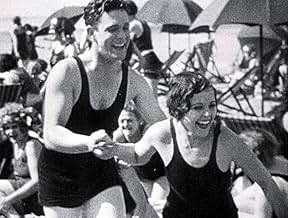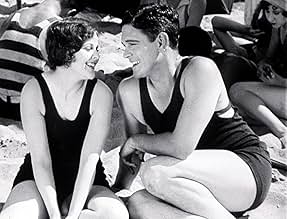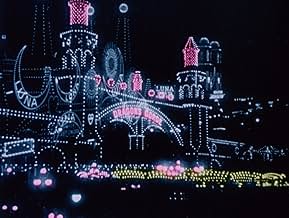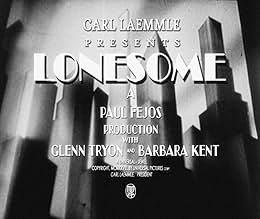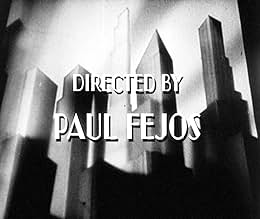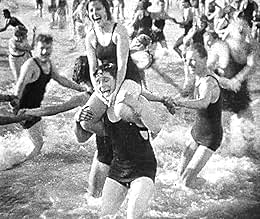Zwei junge Herzen. Eine kleine Episode aus einer grossen Stadt
Originaltitel: Lonesome
IMDb-BEWERTUNG
7,7/10
2818
IHRE BEWERTUNG
Füge eine Handlung in deiner Sprache hinzuTwo lonely people in the big city meet and enjoy the thrills of an amusement park, only to lose each other in the crowd after spending a great day together. Will they ever see each other aga... Alles lesenTwo lonely people in the big city meet and enjoy the thrills of an amusement park, only to lose each other in the crowd after spending a great day together. Will they ever see each other again?Two lonely people in the big city meet and enjoy the thrills of an amusement park, only to lose each other in the crowd after spending a great day together. Will they ever see each other again?
- Auszeichnungen
- 1 wins total
Gusztáv Pártos
- Romantic Gentleman
- (as Gustav Partos)
Henry Armetta
- Ferris wheel guy
- (Nicht genannt)
Edgar Dearing
- Cop
- (Nicht genannt)
Louise Emmons
- Telephone Caller
- (Nicht genannt)
Fred Esmelton
- Swami
- (Nicht genannt)
Jack Raymond
- Barker
- (Nicht genannt)
Churchill Ross
- Telephone Caller
- (Nicht genannt)
Empfohlene Bewertungen
There are at least three levels at which 'Lonesome' is an extremely interesting film.
1. It is a sweet story of two lonely people in a big anonymous city who meet, fall in love and lose each other. The picture is well-acted, and the two lead actors Barbara Kent (Mary) and Glenn Tryon (Jim) are perfectly matched; they both give nuanced and sensitive performances.
2. The style of the picture is almost documentary, which makes it interesting from a social history point of view. In some ways, nothing much has changed over the last 100 years: People are still commuting to work, the subway in New York was as crowded as the London Underground is today (I don't know about New York in 2022), you get annoyed at the same kind of behaviour of your fellow passengers (e.g. Eating smelly food) etc. Obviously other things have changed: The type of work we do, for example, and we no longer bond over serialised novels published in newspapers that we read. Nevertheless, we are still living in what is recognisably the same kind of society. I found this aspect of 'Lonesome' particularly interesting.
3. Technologically, 'Lonesome' was highly innovative, being the perfect example of a film that came out during the transition phase from silent pictures to talkies to colour films. Initially, it looks like a normal black and white silent film to which music and some sound effects have been added. However, some scenes have spoken dialogue, and some are even in colour, or at least partly colorised. People back then must have felt they were living in an exciting age of innovation; I am sure they expected that within the next few years, all talking and maybe even all colour films would become the norm.
So why am I giving 'Lonesome' no more than 8 stars? Well, there are a few flaws. First, the dialogue sounds as stilted as if the actors were reading it from a sheet, and on top of that, a bit of it does not seem to make much sense (the scene at the police). It feels like an afterthought, like something director Pal Fejös inserted after having finished the rest of the film. Second, the colour effects are not particularly nice to look at. The colours are just garish. They were certainly innovative, but the film would look better without them. And finally, the plot is so simple that it barely exists. The only real problem the characters face appears almost at the end of the film, and its resolution does not logically follow from anything that happened earlier; it just comes about by chance. I am reserving 9 stars for pictures that are as good as perfect, and 10 for those that have some particular emotional quality or style that takes them into the small group of my favourite films (like e.g. 'North by Northwest', which for my taste must be one of the most stylish films ever made). 'Lonesome' is very good, but not as good as that. Hence 8 stars.
1. It is a sweet story of two lonely people in a big anonymous city who meet, fall in love and lose each other. The picture is well-acted, and the two lead actors Barbara Kent (Mary) and Glenn Tryon (Jim) are perfectly matched; they both give nuanced and sensitive performances.
2. The style of the picture is almost documentary, which makes it interesting from a social history point of view. In some ways, nothing much has changed over the last 100 years: People are still commuting to work, the subway in New York was as crowded as the London Underground is today (I don't know about New York in 2022), you get annoyed at the same kind of behaviour of your fellow passengers (e.g. Eating smelly food) etc. Obviously other things have changed: The type of work we do, for example, and we no longer bond over serialised novels published in newspapers that we read. Nevertheless, we are still living in what is recognisably the same kind of society. I found this aspect of 'Lonesome' particularly interesting.
3. Technologically, 'Lonesome' was highly innovative, being the perfect example of a film that came out during the transition phase from silent pictures to talkies to colour films. Initially, it looks like a normal black and white silent film to which music and some sound effects have been added. However, some scenes have spoken dialogue, and some are even in colour, or at least partly colorised. People back then must have felt they were living in an exciting age of innovation; I am sure they expected that within the next few years, all talking and maybe even all colour films would become the norm.
So why am I giving 'Lonesome' no more than 8 stars? Well, there are a few flaws. First, the dialogue sounds as stilted as if the actors were reading it from a sheet, and on top of that, a bit of it does not seem to make much sense (the scene at the police). It feels like an afterthought, like something director Pal Fejös inserted after having finished the rest of the film. Second, the colour effects are not particularly nice to look at. The colours are just garish. They were certainly innovative, but the film would look better without them. And finally, the plot is so simple that it barely exists. The only real problem the characters face appears almost at the end of the film, and its resolution does not logically follow from anything that happened earlier; it just comes about by chance. I am reserving 9 stars for pictures that are as good as perfect, and 10 for those that have some particular emotional quality or style that takes them into the small group of my favourite films (like e.g. 'North by Northwest', which for my taste must be one of the most stylish films ever made). 'Lonesome' is very good, but not as good as that. Hence 8 stars.
8sb88
It's a shame Lonesome hasn't been seen more widely by modern audiences. The limited acclaim it's received is well deserved.
Lonesome is very simple. It's no more than a little romantic movie of two people who fall in love and then appear to lose each other. But the whole thing is told expertly well. The camera moves about freely in many unique and interesting ways. Visually alone, it's quite the spectacle. It also helps that the two in the lead roles are enjoyable.
Glenn Tyron is good enough in his lead role, but his romantic interest, played by Barbara Kent, is the real star. She is fun and playful when needed, but her soulful eyes convey more pain then most people ever could with their voices. Her charisma is evident from shot one.
The only downside to the film is the inclusion of a few sound scenes. Clearly done just to cash in on the new craze, it actually only serves to grind the story to a halt. It forces the movie to become stationary, and the dialogue itself is pretty inane.
I cannot recommend the film strongly enough, though. It's as enjoyable of a romance as you'll ever see. There's nothing too complicated here: just two people falling in love, and it's a joy to see.
Lonesome is very simple. It's no more than a little romantic movie of two people who fall in love and then appear to lose each other. But the whole thing is told expertly well. The camera moves about freely in many unique and interesting ways. Visually alone, it's quite the spectacle. It also helps that the two in the lead roles are enjoyable.
Glenn Tyron is good enough in his lead role, but his romantic interest, played by Barbara Kent, is the real star. She is fun and playful when needed, but her soulful eyes convey more pain then most people ever could with their voices. Her charisma is evident from shot one.
The only downside to the film is the inclusion of a few sound scenes. Clearly done just to cash in on the new craze, it actually only serves to grind the story to a halt. It forces the movie to become stationary, and the dialogue itself is pretty inane.
I cannot recommend the film strongly enough, though. It's as enjoyable of a romance as you'll ever see. There's nothing too complicated here: just two people falling in love, and it's a joy to see.
Lonesome is like the much more charming, if slightly less ambitious (and at the very end a bit too cute) cousin of Sunrise. It's appeal is in its simplicity, but where Sunrise was about a couple breaking apart and coming back together, this is much more streamlined and less tragic (though it does go for some tragic beats in the last twenty minutes of its slim 70-minute run-time): boy is lonely, girl is lonely, both work working-class jobs (factory/phone operator, what else in New York city in 1928?), they both decide separately after their (so-called!) friends go off on their own adventures to go to the beach and amusement park - is it Coney Island? I can't imagine it being anywhere else - and boy and girl meet as the boy tries to show off doing games. And that's it, that's the movie, and why it stands out (and got a sort-of restoration and Criterion treatment) is its presentation by its director.
I don't know much about Pal (Paul) Fejos except that he directed silent films and somewhat into the 1930's, and then sort of faded away into obscurity. It's a shame since a film like Lonesome shows his talents clearly: he has a keen sense of editing and that way that silent filmmakers sometimes had to super-impose images (perhaps a chip off the Abel Gance block perhaps, but not as ambitious), in particular when he's setting up the hustle/bustle of the city and then later in the film when things get more harrowing with the characters. That is to say when, inevitably, the main conflict is that they are separated in that great sea of people that makes up a massive crowd in a city (where, as the man, Jim, notes at one point, is so strange that you're surrounded by so many but still feel so alone).
The charm in the film comes in how the couple on screen - Barbara Kent and Glenn Tryon - are together; they're kind of like if you had one of those romantic "leads" in those really early Marx brothers movies, only they don't sing and the man is funny in that amusing- lightly- sarcastic way (i.e. bragging about his "six acres on Wall street" at first, which we and the girl knows isn't true, but it's fun to play along). Actually, speaking of that, this is an experimental film at heart for a number of reasons. It appears at first to be a silent film, and for 90% of it it surely is, and is shot like one with that film speed we associate with silent cinema on the whole (that kind of slightly-sped-up speed where its rhythm is distinctly of its cameras and era), and we know this because 10% of the film, more or less, is a *sound* film. No, really, we suddenly move from what is the obvious fluid camera style and wide shots of the crowds and intensity that comes with a camera that moves freely to what is clearly static shots in a studio so the actors are right under a microphone... and the acting is just as static.
That's not totally fair; this is considered, at least according to the trivia, one of the very first films to ever incorporate sound. On that level it's certainly extraordinary and important, but the problem is that it becomes jarring with the rest of the film which is shot with such passion and excitement (it's also frankly weird to hear the actor's speaking voices, whereas before, like I do with a lot of silent movies, I can think of my own voices for the actors that do not sound so... stilted). One of the sound scenes is also one where I wasn't sure if a cop was being sarcastic or not; our man Jim has been taken away by the cops after a roller-coaster ride where Mary, the girl, fainted and had to be taken away but Jim got separated and got rough with a cop. For a moment it seems like he'll be put away, but Jim pours his heart out (with some, I'm sorry, cringe-inducing lines), and the cop's reaction is hard to read since it sounds totally "pfft yeah right"... but then they let him go. Very strange.
But these aren't major complaints for a film that has so much to offer outside of those things. This is a movie that's joy is in its purity, that it's about these two people and how they meet and suddenly all of the usual problems of their everyday lives - the work, the drudgery, the intensity of being around so many people getting on/off the subways or being in the traffic - can float away since they have one another. And there are some moments of experimentation that do work, mostly involving (also, again, a touch of daring with Fejos) color: there's tinted scenes here, which isn't unusual for a silent film, but here it's how the colors are used, over the amusement park scenes to illuminate the lights at night, the performers in the park, the vibrancy that the night off a beach in the city brings.
There are so many moments of rich filmmaking, so much hope that this couple is able to inspire in a short amount of time, and because of the simplicity we're able to invest ourselves into their bond as it gets closer (maybe a little *too* quick, one might want to argue, falling in love within a day), that one can almost forgive a cutesy ending. Almost.
I don't know much about Pal (Paul) Fejos except that he directed silent films and somewhat into the 1930's, and then sort of faded away into obscurity. It's a shame since a film like Lonesome shows his talents clearly: he has a keen sense of editing and that way that silent filmmakers sometimes had to super-impose images (perhaps a chip off the Abel Gance block perhaps, but not as ambitious), in particular when he's setting up the hustle/bustle of the city and then later in the film when things get more harrowing with the characters. That is to say when, inevitably, the main conflict is that they are separated in that great sea of people that makes up a massive crowd in a city (where, as the man, Jim, notes at one point, is so strange that you're surrounded by so many but still feel so alone).
The charm in the film comes in how the couple on screen - Barbara Kent and Glenn Tryon - are together; they're kind of like if you had one of those romantic "leads" in those really early Marx brothers movies, only they don't sing and the man is funny in that amusing- lightly- sarcastic way (i.e. bragging about his "six acres on Wall street" at first, which we and the girl knows isn't true, but it's fun to play along). Actually, speaking of that, this is an experimental film at heart for a number of reasons. It appears at first to be a silent film, and for 90% of it it surely is, and is shot like one with that film speed we associate with silent cinema on the whole (that kind of slightly-sped-up speed where its rhythm is distinctly of its cameras and era), and we know this because 10% of the film, more or less, is a *sound* film. No, really, we suddenly move from what is the obvious fluid camera style and wide shots of the crowds and intensity that comes with a camera that moves freely to what is clearly static shots in a studio so the actors are right under a microphone... and the acting is just as static.
That's not totally fair; this is considered, at least according to the trivia, one of the very first films to ever incorporate sound. On that level it's certainly extraordinary and important, but the problem is that it becomes jarring with the rest of the film which is shot with such passion and excitement (it's also frankly weird to hear the actor's speaking voices, whereas before, like I do with a lot of silent movies, I can think of my own voices for the actors that do not sound so... stilted). One of the sound scenes is also one where I wasn't sure if a cop was being sarcastic or not; our man Jim has been taken away by the cops after a roller-coaster ride where Mary, the girl, fainted and had to be taken away but Jim got separated and got rough with a cop. For a moment it seems like he'll be put away, but Jim pours his heart out (with some, I'm sorry, cringe-inducing lines), and the cop's reaction is hard to read since it sounds totally "pfft yeah right"... but then they let him go. Very strange.
But these aren't major complaints for a film that has so much to offer outside of those things. This is a movie that's joy is in its purity, that it's about these two people and how they meet and suddenly all of the usual problems of their everyday lives - the work, the drudgery, the intensity of being around so many people getting on/off the subways or being in the traffic - can float away since they have one another. And there are some moments of experimentation that do work, mostly involving (also, again, a touch of daring with Fejos) color: there's tinted scenes here, which isn't unusual for a silent film, but here it's how the colors are used, over the amusement park scenes to illuminate the lights at night, the performers in the park, the vibrancy that the night off a beach in the city brings.
There are so many moments of rich filmmaking, so much hope that this couple is able to inspire in a short amount of time, and because of the simplicity we're able to invest ourselves into their bond as it gets closer (maybe a little *too* quick, one might want to argue, falling in love within a day), that one can almost forgive a cutesy ending. Almost.
10clanciai
The striking character of this film is its extreme intensity in a fantastic camera work that keeps rushing on in breathless frenzy to the very bitter end of the film. It's almost like a documentary in its constant flow of following the crowds from the working places to the reckless carneval of Coney Island, never leaving the strenuous hard pace of life for one second, except for the moments when the lovers find each other. Then there is a touch of poetry, which also marks the film with a totally different character, which makes it doubly interesting. This film is like no other film, the closest in likeness is actually Eisenstein's "Battleship Potemkin" which also wallows in following the crowds in wild frenzy, but here the lovers provide some privacy and individualism, which is totally missing in Eisenstein's masterpiece, and this is certainly a masterpiece of the same rank but on a different level, for its very human touch of simplicity and basic togetherness. There are also some resemblance to Fritz Lang's "Liliom" with Charles Boyer, which also renders the carneval and wild pleasure hunting in frenzied rush of popular festivity in unforgettable cinematography.
Paul Fejos made many documentaries, he was a master and genius in observing and capturing life at its most original and basic level, his documentaries are from Madagascar, South East Asia, Peru apart from Europe and America, he made altogether 44 films, and this is just an example of his extremely personal and highly advanced art of the film.
Paul Fejos made many documentaries, he was a master and genius in observing and capturing life at its most original and basic level, his documentaries are from Madagascar, South East Asia, Peru apart from Europe and America, he made altogether 44 films, and this is just an example of his extremely personal and highly advanced art of the film.
A sister of Sunrise and The Crowd, this film is more emotional and poetic than those landmarks and every bit as great. The plot concerns two working class American types, he works in the factory, she works on the intercom who meet by chance on a fairground and fall in love and then lose each other without knowing where the other lives.
The film's beginning is to be treasured, it follows in detail the morning ritual of first the girl and then the man in their respective homes. The effect conveyed is the organization and elegance of women over the tardy, rushed, half-baked activities of men. The love story between the two characters is so beautifully etched and played so naturalistically by the actors(Barbara Kent and Glenn Tryon) that the sense of loss in the latter half of the film is all the more painful and heart-breaking. The film deals with a certain truth about living in a city that has remained constant even after a good 80 years. At once a constant sense of community and at other an equally constant sense of loneliness from being in a crowd.
The film's beginning is to be treasured, it follows in detail the morning ritual of first the girl and then the man in their respective homes. The effect conveyed is the organization and elegance of women over the tardy, rushed, half-baked activities of men. The love story between the two characters is so beautifully etched and played so naturalistically by the actors(Barbara Kent and Glenn Tryon) that the sense of loss in the latter half of the film is all the more painful and heart-breaking. The film deals with a certain truth about living in a city that has remained constant even after a good 80 years. At once a constant sense of community and at other an equally constant sense of loneliness from being in a crowd.
Wusstest du schon
- WissenswertesIt was one of the first motion pictures to have sound and a couple of talking scenes. It was released in both silent and monaural versions. Some scenes in existing original prints of the film are colored with stencils.
- Alternative VersionenProduced in both sound and silent versions. The sound version was 6,785 feet in length, and the silent version was 6,193 feet.
- VerbindungenFeatured in Fejezetek a film történetéböl: Az amerikai film kezdetei (1989)
- SoundtracksAlways
(uncredited)
Written by Irving Berlin
[Played by dance orchestra at ballroom]
Sung by Nick Lucas
[on Brunswick recording played in last scene]
Top-Auswahl
Melde dich zum Bewerten an und greife auf die Watchlist für personalisierte Empfehlungen zu.
- How long is Lonesome?Powered by Alexa
Details
- Laufzeit
- 1 Std. 9 Min.(69 min)
- Sound-Mix
- Seitenverhältnis
- 1.19:1
Zu dieser Seite beitragen
Bearbeitung vorschlagen oder fehlenden Inhalt hinzufügen



